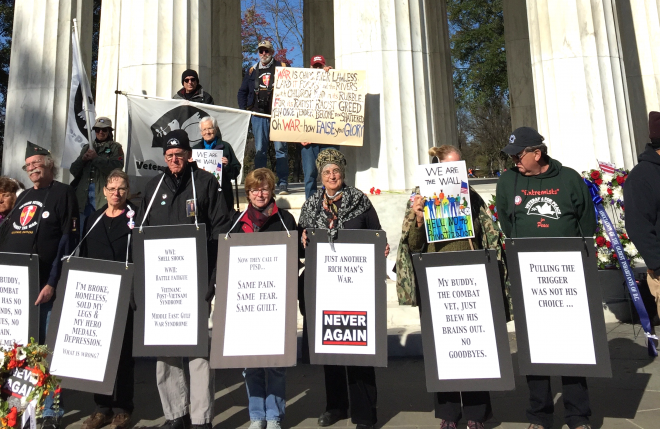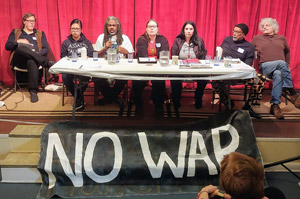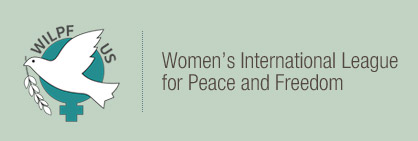WILPFers Attend Inspiring Peace Congress and Armistice Day Rally
Published on December, 26 2018
A march to reclaim Armistice Day organized by Veterans for Peace began near the World War II memorial, went on to the memorials for the Korean War and Vietnam War, and ended at the World War I Memorial. Photo: Nancy Price.
By Odile Hugonot-Haber and Nancy Price
On November 10th, Odile Hugonot-Haber, Alan Haber, and Nancy Price met up at the Peace Congress in Washington, DC, and to participate on Sunday the 11th in a rally organized by Veterans for Peace on the 100th Anniversary of the World War I Armistice.
When Trump announced he wanted a huge military parade on Nov. 10, the No Trump Military Parade coalition came together to stop the parade. By August 2018, 250 groups, including WILPF US, Disarm and Earth Democracy, signed on to an open letter, the estimated $92 million cost was leaked, and on August 17 Trump canceled the parade.
After continuing discussions, the idea for a Peace Congress to End Wars at Home and Abroad took form. On November 10, advocates for peace and economic, racial, environmental, and climate justice came together to develop a strategy, goals, and actions based on the following principles of unity:
- End US wars at home and abroad
- Create a peace economy that meets the necessities of people and protects the planet
- Respect the self-determination of all people and nations
- Create transformative change by building a movement of movements
 The inspiring day started off with an opening panel of speakers who focused on the current environment of the social and economic “wars” at home and US imperialism abroad, and ways to build the peace movement. The plenary speakers included: Joe Lombardo, UNAC: United National Antiwar Coalition; Ajamu Baraka, Black Alliance for Peace & 2016 Green Party Presidential Candidate; Cheri Honkala, Poor People's Economic Human Rights Campaign & 2012 Vice Presidential Campaign; Angela Bibens, Red Owl Law and Standing Rock Legal Collective; Netfa Freeman, Institute for Policy Studies, who works on issues of African solidarity and police violence; Bernadette Ellorin, BAYAN-USA, who spoke about the Philippines.
The inspiring day started off with an opening panel of speakers who focused on the current environment of the social and economic “wars” at home and US imperialism abroad, and ways to build the peace movement. The plenary speakers included: Joe Lombardo, UNAC: United National Antiwar Coalition; Ajamu Baraka, Black Alliance for Peace & 2016 Green Party Presidential Candidate; Cheri Honkala, Poor People's Economic Human Rights Campaign & 2012 Vice Presidential Campaign; Angela Bibens, Red Owl Law and Standing Rock Legal Collective; Netfa Freeman, Institute for Policy Studies, who works on issues of African solidarity and police violence; Bernadette Ellorin, BAYAN-USA, who spoke about the Philippines.
The rest of the day was admirably facilitated by Margaret Flowers as an open general assembly with participants—movement leaders and activists—using a SWOT (strengths, weaknesses, opportunities, and threats) analysis to identify the strengths of ongoing campaigns, obstacles to building a stronger and more effective movement, opportunities, goals, and next steps. In particular, the Peace Congress called for building race and age diversity into the movement.
Flip-chart pages were posted around the room listing current campaigns and calendar of activities in the US. Four points for future organizing were identified: 1. Political influence, 2. Nurture future generations, 3. Connect to the working class, and 4. Mobilization and long-term planning.
During general discussion, Odile writes: “Alan and I spoke about The Megiddo Peace and said that rather than speak of the ‘war system,’ we wanted to emphasize building a peace culture and consolidating the peace movement in order to gather together demands and bridge silos. We spoke of building a peace infrastructure like obtaining State Commissions for Peace and Justice and a Department of Peace, and of the need to actively assemble all the demands for Peace and Justice from the many organizations, presenting them in a comprehensive and organized list, and pushing them forward during the 2020 elections.”
 The next day, Sunday, Odile, Alan, and Nancy again met up at the #ReclaimArmisticeDay rally, a day to remember the horrors of war and the need for peace. Armistice Day is celebrated in most countries around the world, but in 1954 President Eisenhower renamed this day Veterans Day.
The next day, Sunday, Odile, Alan, and Nancy again met up at the #ReclaimArmisticeDay rally, a day to remember the horrors of war and the need for peace. Armistice Day is celebrated in most countries around the world, but in 1954 President Eisenhower renamed this day Veterans Day.
Kevin Zeese summarizes the day: Veterans who served in different wars and military families impacted by the war spoke followed by allied groups working for peace. The group then began a solemn march near the World War II memorial and on to the memorials for the Korean War, Vietnam War, and World War I.
The march was led by a single-file procession of veterans wearing signs that described the reality of war. There was one person with a sign for each of the 20.6 veterans, mostly under 35, who commit suicide each day (see the signs in the opening photo). At each memorial, the group placed a wreath. The march showed opposition to war when many were visiting memorials commemorating war on Veteran’s Day. Here’s a short history of Armistice Day.



